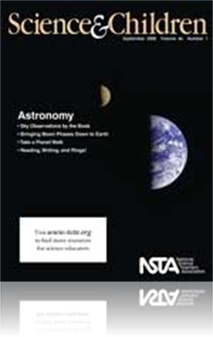All Science and Children resources
Journal Article
The National Science Education Standards (NSES) state that students in grades K—4 are expected to understand that astronomical objects in the sky, including the Sun, Moon, and stars—have properties, locations, and patterns of movement that can b...
Journal Article
Methods and Strategies: The Science Representation Continuum
Research indicates that people more easily understand abstractions when they are preceded by concrete representations (Lawson 2002). This article describes how educators can use science representations to help students form lasting understandings of ...
Journal Article
Teaching Through Trade Books: Moon Phases and Models
From the time they are very young, children are naturally curious about the Moon. They may wonder about the different shapes of the Moon when they look up at the night sky. In this month’s primary lesson, students discover through direct observatio...
Journal Article
Physical models in the classroom “cannot be expected to represent the full-scale phenomenon with complete accuracy, not even in the limited set of characteristics being studied” (AAAS 1990). Therefore, by modifying a popular classroom activity ca...
Journal Article
A Message from the NSTA President: Science Education—The Times They are A-Changin’
Inspired by her favorite Bob Dylan song of 1964, “The Times They Are A-Changin”—NSTA President Page Keeley’s presidential theme during her 2008-09 tenure will be “From Transition to Transformation—Striving for a Science-Literate Nation.�...
Journal Article
The Moon’s Phases and the Self Shadow
In this article, the authors present a new way of teaching the phases of the Moon. Through the introduction of a self shadow (an idea of a shadow that is not well-known), they illuminate students’ understanding of the phases of the Moon and help th...
Journal Article
Perspectives: A (Mis)Understanding of Astronomical Proportions?
Misconceptions are ideas formulated by children as they try to make sense of the world. By focusing on students’ ideas, using the strategies suggested in this article, teachers can help students move toward more accurate understandings of the solar...
Journal Article
Earth Science Week (ESW) 2008 encourages people around the globe to open doors and investigate new opportunities. This year’s theme, “No Child Left Inside,” is a call to explore our natural environments. The celebration urges everyone—especia...
Journal Article
Every Day Science Calendar: September 2008
This monthly feature contains facts and challenges for the science explorer. ...


